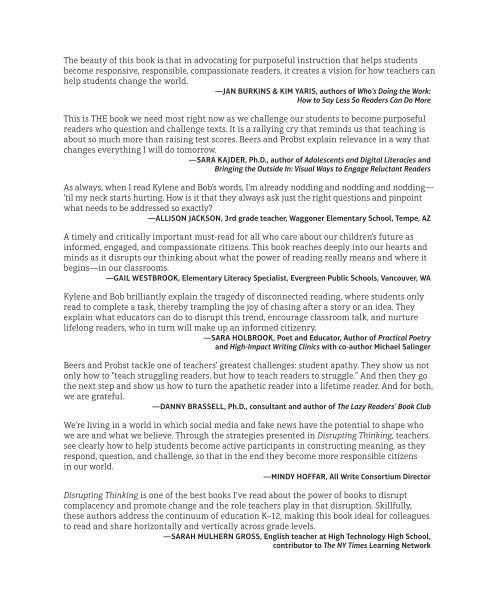chapter
2okDLts
2okDLts
Create successful ePaper yourself
Turn your PDF publications into a flip-book with our unique Google optimized e-Paper software.
The beauty of this book is that in advocating for purposeful instruction that helps students<br />
become responsive, responsible, compassionate readers, it creates a vision for how teachers can<br />
help students change the world.<br />
—JAN BURKINS & KIM YARIS, authors of Who’s Doing the Work:<br />
How to Say Less So Readers Can Do More<br />
This is THE book we need most right now as we challenge our students to become purposeful<br />
readers who question and challenge texts. It is a rallying cry that reminds us that teaching is<br />
about so much more than raising test scores. Beers and Probst explain relevance in a way that<br />
changes everything I will do tomorrow.<br />
—SARA KAJDER, Ph.D., author of Adolescents and Digital Literacies and<br />
Bringing the Outside In: Visual Ways to Engage Reluctant Readers<br />
As always, when I read Kylene and Bob’s words, I’m already nodding and nodding and nodding—<br />
’til my neck starts hurting. How is it that they always ask just the right questions and pinpoint<br />
what needs to be addressed so exactly?<br />
—ALLISON JACKSON, 3rd grade teacher, Waggoner Elementary School, Tempe, AZ<br />
A timely and critically important must-read for all who care about our children’s future as<br />
informed, engaged, and compassionate citizens. This book reaches deeply into our hearts and<br />
minds as it disrupts our thinking about what the power of reading really means and where it<br />
begins—in our classrooms.<br />
—GAIL WESTBROOK, Elementary Literacy Specialist, Evergreen Public Schools, Vancouver, WA<br />
Kylene and Bob brilliantly explain the tragedy of disconnected reading, where students only<br />
read to complete a task, thereby trampling the joy of chasing after a story or an idea. They<br />
explain what educators can do to disrupt this trend, encourage classroom talk, and nurture<br />
lifelong readers, who in turn will make up an informed citizenry.<br />
—SARA HOLBROOK, Poet and Educator, Author of Practical Poetry<br />
and High-Impact Writing Clinics with co-author Michael Salinger<br />
Beers and Probst tackle one of teachers’ greatest challenges: student apathy. They show us not<br />
only how to “teach struggling readers, but how to teach readers to struggle.” And then they go<br />
the next step and show us how to turn the apathetic reader into a lifetime reader. And for both,<br />
we are grateful.<br />
—DANNY BRASSELL, Ph.D., consultant and author of The Lazy Readers’ Book Club<br />
We’re living in a world in which social media and fake news have the potential to shape who<br />
we are and what we believe. Through the strategies presented in Disrupting Thinking, teachers<br />
see clearly how to help students become active participants in constructing meaning, as they<br />
respond, question, and challenge, so that in the end they become more responsible citizens<br />
in our world.<br />
—MINDY HOFFAR, All Write Consortium Director<br />
Disrupting Thinking is one of the best books I’ve read about the power of books to disrupt<br />
complacency and promote change and the role teachers play in that disruption. Skillfully,<br />
these authors address the continuum of education K–12, making this book ideal for colleagues<br />
to read and share horizontally and vertically across grade levels.<br />
—SARAH MULHERN GROSS, English teacher at High Technology High School,<br />
contributor to The NY Times Learning Network


